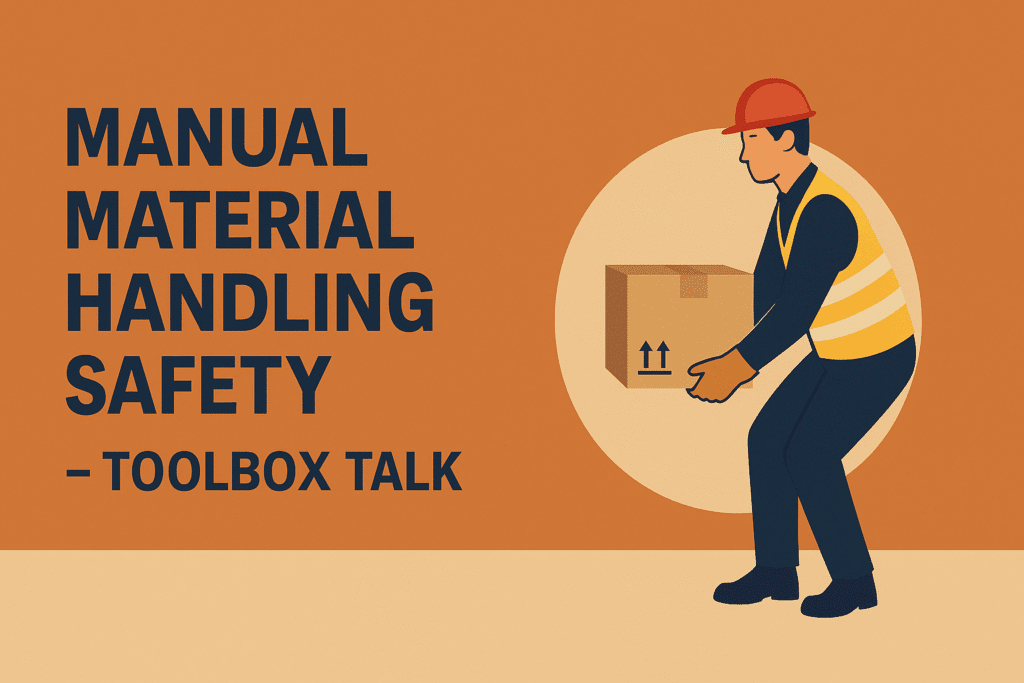
Manual Material Handling Safety TBT
Good morning team,
Today’s safety talk is about Manual Material Handling — one of the most common tasks we do, and one that causes more workplace injuries than almost anything else.
Manual handling means lifting, carrying, pushing, pulling, or moving loads by hand or bodily force. It may sound simple, but the reality is, if done incorrectly, it can lead to serious injuries — especially to your back, shoulders, and knees.
In fact, sprains and strains from manual handling are a major cause of lost workdays in construction, warehousing, and manufacturing. The good news? Almost all manual handling injuries are preventable with the right techniques and planning.
1. Why Manual Material Handling Safety Matters
- Lifting injuries can cause long-term back problems.
- Poor lifting techniques increase the risk of hernias, slipped discs, and muscle tears.
- Even fit, strong workers are at risk — injuries can happen suddenly or develop over time.
- Repeated poor handling leads to chronic pain and reduced mobility.
2. Hazards in Manual Handling
2.1 Overexertion
- Trying to lift something too heavy without help.
- Carrying a load too far.
2.2 Poor Posture
- Bending at the waist instead of the knees.
- Twisting the spine while lifting.
2.3 Repetitive Movements
- Frequent lifting over time causes wear and tear on muscles and joints.
2.4 Unstable Loads
- Items that shift or move while being carried.
- Awkward shapes that are hard to grip.
2.5 Slips, Trips, and Falls
- Carrying loads that block your view.
- Walking on uneven or slippery surfaces.
3. The Safe Lifting Process
The safest lift is the one you don’t do manually — but if you must, follow these steps:
- Assess the Load
- Can you lift it alone, or do you need help or equipment?
- Check for sharp edges, leaks, or awkward shapes.
- Plan the Lift
- Clear your path of obstacles.
- Identify a safe place to set the load down.
- Make sure the route is dry and even.
- Get a Good Grip
- Use both hands.
- Keep fingers clear of pinch points.
- Position Your Body
- Stand close to the load with feet shoulder-width apart.
- Bend your knees, not your back.
- Lift Smoothly
- Use your leg muscles, keeping your back straight.
- Avoid jerking movements.
- Carry Safely
- Keep the load close to your body.
- Look ahead, not at your feet.
- Set Down Properly
- Bend your knees and lower the load slowly.
- Don’t release your grip until the load is stable.
4. Using Mechanical Aids
- Whenever possible, use trolleys, pallet jacks, forklifts, or conveyors.
- Using equipment is not a sign of weakness — it’s a sign of working smart.
5. Team Lifting
- Choose a partner of similar height and strength.
- Communicate clearly — agree on “lift” and “lower” signals.
- Lift and move in unison.
6. PPE for Manual Handling
- Safety boots with slip-resistant soles.
- Gloves for grip and hand protection.
- Back support belts (where recommended — but not a substitute for good technique).
7. Do’s and Don’ts
✅ Do:
- Test the weight before lifting.
- Keep loads close to your body.
- Ask for help with heavy or awkward loads.
- Take breaks during repetitive lifting tasks.
❌ Don’t:
- Twist your body while carrying a load.
- Carry something so large it blocks your view.
- Lift above shoulder height without assistance.
- Rush your lift — speed leads to injury.
8. Real-Life Case Study
A warehouse worker attempted to carry a large, awkward box alone instead of asking for help. While turning, he twisted his back and dropped the load, resulting in a slipped disc that required surgery.
Lesson: It’s better to spend 2 minutes finding help or equipment than months recovering from an injury.
9. Worker Engagement – Q&A
- What’s the best way to lift a load from the floor?
- When should you ask for help with a lift?
- Why is twisting during a lift dangerous?
10. Closing Words – Bringing It Back to the Start
Alright team, we started this morning talking about how manual handling is one of the most common tasks we perform. Because it’s so common, it’s easy to forget the risks — but those risks are real and can be life-changing.
Good lifting technique, proper planning, and knowing your limits will protect your back for years to come. Remember, there’s no medal for lifting something alone — but there is pain if you get it wrong.
Let’s lift with our legs, keep our backs straight, and work together to move heavy loads safely.
Stay alert, stay safe, and let’s have a productive day.
Reporting Near Misses 5 Minute Safety Talk
Heat Stress and Hydration 5 Minute Safety Talk